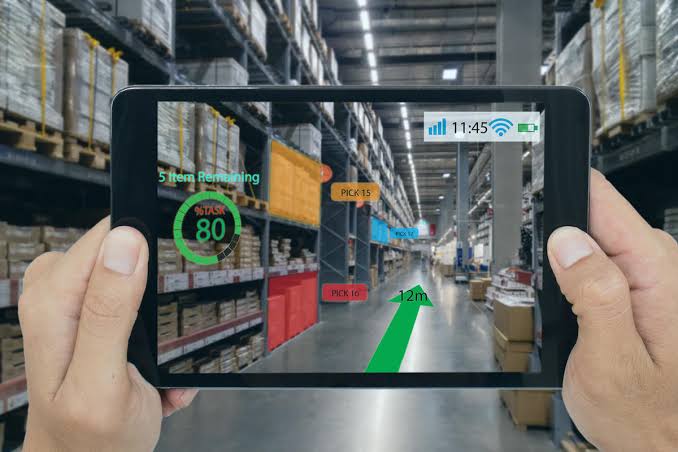How AR and IIoT Are Transforming Manufacturing, by: Alfredo Patron, SCB Contributor
Today’s industrial workers are able to see and do things that would have been impossible just a decade ago. Augmented reality (AR), an innovative digital technology, is both enhancing what people can see and how they can use that added information to accomplish specific tasks. And it couldn’t have come at a better time.
The level of competition in the manufacturing sector has greatly intensified, expanding on a global scale and driven by imperatives to lower costs, shorten lead times, and improve quality control. Productivity improvement, process optimization, and maximum return on investment have become the watchwords of industrial production worldwide. And throughput volumes today are at historic highs.
Sustaining these levels of production requires a lot of moving parts, both literally and figuratively. One of the most critical is the need to minimize unplanned downtime of production machinery, much of which is now digitally controlled, having long ago replaced traditional electromechanical shop-floor equipment.
All machinery, whether electronic or mechanical, requires maintenance. Keeping up with the constantly changing conditions of that equipment, as well as issues affecting materials, inventories, production quality, and physical security, is a huge challenge. To stay on top of it, a growing number of companies are outfitting their manufacturing facilities with an assortment of remote sensors, cameras, robots, meters, and controls. And all are connected by the internet to one another, as well as to centralized monitoring stations. Collectively, those devices constitute the industrial internet of things (IIoT), and are at the heart of emerging digitally enabled manufacturing plants.
At the same time, the sophistication of the equipment often requires technicians with specialized training to set up, diagnose, maintain, and repair them — an ability that isn’t widely available in today’s workforce. Although machine operators are typically able to handle routine problems and report other issues to their tech support staffs, they aren’t usually expected to know every technical detail of their equipment. But with guidance from specialists, they can push the right levers or adjust appropriate settings to fix problems themselves.
That’s where AR comes in. It allows expert technicians, even thousands of miles away, to help workers solve machine problems, amplifying the power of local personnel to create real value.
AR starts with a user looking at images onscreen. They could originate either from a local IIoT device or from their own handheld camera. But what they see on their screen — which could be on a phone, tablet, PC, or even smart glasses — is augmented with additional visual information. That new data could be overlaid from a computer, displaying relevant graphics or highlighting certain items of interest in the viewing area so they can be more quickly and easily identified by the person on site.
Alternatively, something highlighted onscreen could originate offsite, providing remote guidance to the person at the scene by, for example, drawing a circle around the object of interest. Such images are normally accompanied by voice communication between the connected locations, allowing the people at both ends to talk about what they’re doing in real time.
For example, if the maker of a milling machine has a customer who needs to install a specialized laser cutting bit, by using an AR app, the company can leverage its expert technicians to walk that customer through the process without sending someone onsite. Of course, a lot of wires, switches, and ports look very similar, and it would be easy for a machine operator to get confused, frustrated, and make mistakes. But with AR apps, a customer can hold their smartphone or tablet up to the device and provide the remote technical expert with a live video stream, showing the exact configuration in question. That technician can then draw circles, add arrows, or text annotations around the image to specify the parts and guide the onsite customer through the sequence of steps, all from a remote computer. To make sure the highlighted item remains in view, the video stream can be paused to freeze the image, so that people at both ends of the connection can examine and discuss its technical details.
Qualified inspections of scheduled maintenance work, repairs, or troubleshooting diagnostics, even if they’re half a world away, can be conducted by certified experts from a central location without the need for onsite visits. There’s no need to wait for a breakdown to occur. Anomalies can be detected by IIoT sensors and repaired proactively, minimizing unplanned downtimes. The same remotely connected AR platform used for inspections and repairs can also become the foundation for other high-value initiatives, such as training.
One Tennessee company sells and services building systems using AR to help its field technicians with installations and repairs. By giving expert support from a central location in real time, the company saves more than $500 a month per technician in labor and travel costs — a 20:1 return on its investment in AR technology.
As a result, AR and IIoT are becoming mainstream technologies. A 2017 survey commissioned by PricewaterhouseCoopers found that 28% of the manufacturing companies it studied were already using strategies for enhanced visualization and automation, such as mobile apps and virtual or augmented reality, although only 12% had entered into extensive deployments. Within five years, that number is projected to grow to 62%. Across all industries, IoT revenues are projected to exceed $500 billion as early as 2021, involving more than 35 billion smart and connected endpoints.
While early adopters have paved the way, others are now realizing they must act quickly or face the risk of missing out on the tremendous competitive edge that the pairing of IIoT with AR now offers. As they come around, the extraordinary promise of a digitally transformed economy will become a tangible reality.
(Alfredo Patron is executive vice president of business development at TeamViewer)

